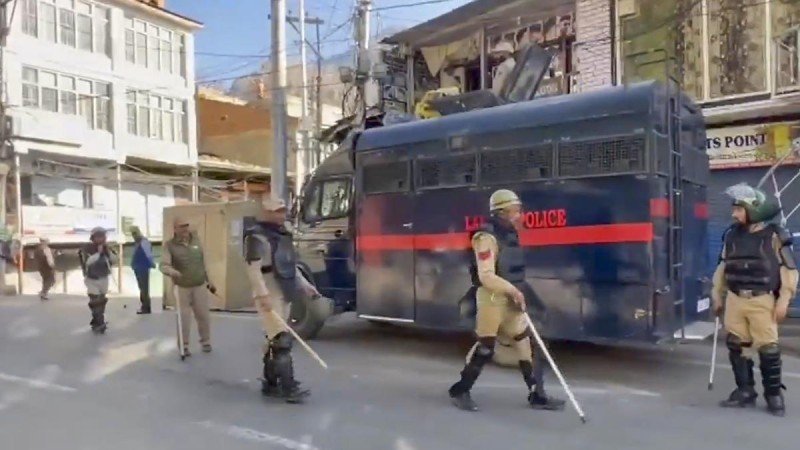The fragile calm in the Union Territory of Ladakh was shattered this week as violent Ladakh Statehood Clashes left four people dead and more than seventy injured. The unrest, which escalated after a large gathering of protesters turned confrontational, has thrown fresh light on the deep-seated political and cultural aspirations of the people of Ladakh. What began as a call for more autonomy quickly spiraled into chaos, raising urgent questions about governance, security, and the delicate balance between local identity and national priorities.
The Roots of the Statehood Demand
Ladakh has always been unique in its cultural, geographical, and strategic context. Carved out as a separate Union Territory in 2019, the region was initially promised greater autonomy and direct governance benefits. However, over time, residents have voiced dissatisfaction with the limited political representation and lack of legislative powers that a Union Territory offers.
Leaders of local organizations argue that statehood would provide Ladakh with its own elected legislative assembly and more control over development policies. Many believe that such status is essential to preserve the fragile Himalayan ecosystem, protect indigenous rights, and address local economic aspirations. These longstanding grievances set the stage for the recent Ladakh Statehood Clashes.
The Clashes and Their Aftermath
On the day of the violence, thousands had gathered in Leh to press their demands. Witnesses report that the protest began peacefully but tensions rose after a heavy police presence was deployed. Skirmishes broke out, and soon the situation spiraled beyond control. Security personnel used batons and tear gas, while some groups of protesters allegedly responded with stones and improvised weapons.
By the end of the day, four people had lost their lives. Hospitals in Leh and nearby districts admitted over seventy people with varying injuries. Authorities responded by imposing curfews, suspending mobile internet services, and bringing in reinforcements. The tragic events highlight the urgent need to address the root causes behind the Ladakh Statehood Clashes through dialogue and political reform.
Political Fallout
The incident has already sparked heated political debates in New Delhi. Opposition parties have criticized the central government for what they call a failure to anticipate and address Ladakh’s growing grievances. Ruling party leaders, however, maintain that the violence was instigated by fringe elements and that dialogue is the only way forward.
The situation in Ladakh is being closely monitored not just for its internal political significance but also for its strategic importance. The region shares sensitive borders with China and Pakistan, making any instability a matter of national concern. Experts warn that ignoring the aspirations of Ladakh’s people could have long-term security and diplomatic consequences.

The Human Cost of Unrest
Beyond politics and security, the tragedy of the clashes lies in the human cost. Families are grieving for their loved ones, while survivors face long recoveries. Local businesses in Leh’s bustling markets have been shuttered, tourism has slowed, and the fragile economy is already feeling the pinch.
The unrest also highlights the broader challenges of governance in regions with complex cultural identities. Much like debates around GST reforms that sought to bring economic relief to the middle class, the Ladakh crisis underscores how governance must balance local needs with national strategies. The recent Ladakh Statehood Clashes serve as a grim reminder of these challenges.
Calls for Dialogue and Resolution
Civil society groups, religious leaders, and youth organizations have appealed for calm and urged both sides to return to the table. Dialogue, they argue, remains the only sustainable way to resolve Ladakh’s political aspirations. Several national commentators have suggested the creation of a special committee to explore constitutional solutions that can meet local demands without jeopardizing national interests.
The government, for its part, has indicated openness to talks but insists that peace and law-and-order must be restored first. Whether this cycle of unrest will end in constructive dialogue or continued confrontation remains to be seen.
Wider Implications for India
The unrest in Ladakh is not an isolated incident but part of a broader narrative of how India’s diverse regions negotiate their place within the federal framework. From economic reforms to startup growth, India’s story is one of constant balancing between local aspirations and national ambitions.
Just as Startups to Watch in the Indian Market highlight how regional innovation can reshape the economy, Ladakh’s statehood movement illustrates how local political aspirations can reshape governance debates. Both are reminders that India’s strength lies in its ability to integrate diversity with unity.
Conclusion
The violent Ladakh Statehood Clashes serve as a stark reminder of the urgent need for responsive governance. Four lives have been lost, dozens injured, and an entire region left shaken. As the dust settles, what matters most is not just restoring order but ensuring that Ladakh’s aspirations are heard and addressed with seriousness.
India cannot afford to ignore Ladakh, either for its strategic importance or for the democratic principles at stake. A careful balance of security, dialogue, and political reform is the only path forward if Ladakh’s people are to feel truly integrated into the national fabric.








